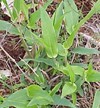Deer Tongue Leaf – Trilisa spp.
|
Current Demand = Normal |
Parts Used: Leaves |


Family: Grass Family Gramineae
Common Names: dichanthelium clandestinum Vanilla Leaf. Wild Vanilla. Trilissia odorata…
Description:
Deer-tongue grass is an annual native species that grows primarily in clumps in the southeastern United States. The leaves can reach 7-8 inches in length and a width of 12-25mm and they are without hairs on either surface and resemble a “deer’s tongue”. The bases of the leaf blades completely surround the sheath and are heart shaped. The leaves are used to flavour tobacco. Their perfume is largely due to Coumarin, which can be seen in crystals on the upper side of the smooth leaves. Flowers – Small, oval flowers are borne on fine stalks in an open, sparse, branched flower head, 3 to 6 inches long. Flower heads that are produced in late summer and fall are often almost completely enclosed within the leaf sheaths.
Growing region: Deer Tongue can be found thru-out the southeastern United States from North Carolina south to Florida and west to Mississippi. It is often found in pine barrens.
Planting/Cultivation:
Deer-tongue grass grows best in damp sandy soil, although it is tolerant of drier environments, and can be found in marshy ground, thickets, gardens, wood margins, stream banks, roadsides, and shorelines. Deer tongue does not grow well on high, dry land or in swampy, wet areas but prefers damp pine flat woods that have been kept open with prescribed fire. It is common throughout North America.
Harvesting/Drying
Parts used: leaves
For maximum potency Deer Tongue should be harvested in the mid to late summer months while the plant is in bloom. When gathering Deer Tongue, only harvest the leaves not the stem or root. Cut the leaf off at ground level to allow the root system to stay in tact for future growth. Gather the larger more mature plants leaving plenty of younger smaller plants to seed the area for future harvest. For drying purposes and to preserve the green color gather in the afternoon once the morning dew has dried.
After harvest, remove all foreign matter (rocks, weeds and pine needles) and spread in a thin layer immediately. Deer Tongue leaf can be dried outdoors though it needs to be dried out of the sun. At night cover your leaves to keep the dew from setting on the drying herb. When possible dry indoors in a well ventilated barn loft or attic to protect from the elements. If natural heat is not available you may need to add heat and a fan for continuous airflow. Hanging lightly filled mesh bags from the rafters works well for drying Deer Tongue. Whether you dry indoors or outdoors you will need to turn or stir the leaf daily.
The key to drying any root, herb or bark is an even combination of heat and airflow. Never dry in an oven or microwave.
The Deer Tongue will be completely dry (largest stem will snap not bend) in 3-7 days depending on the drying conditions. Once it is dried place the leaves carefully into a cardboard box or paper bag for storage in a dry area until you are ready to sell or use. Never store Deer Tongue in plastic or it will mold.
 Root Buyer
Root Buyer